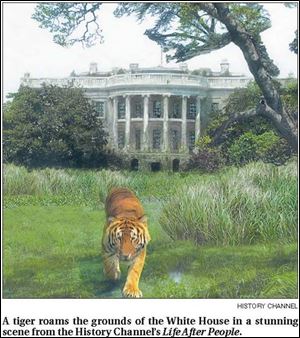
Where have all the people gone?
1/19/2008
Welcome to Earth. Population: 0.
It's not easy to imagine this planet of ours without any people on it, but thanks to the History Channel, we can get a fascinating and unsettling look at what just might happen if mankind was suddenly and completely removed from the equation.
A two-hour special called Life After People, which premieres Monday at 9 p.m., provides a thought-provoking and visually stunning portrait of what the world would most likely be like without any of us around.
And guess what? It looks like Earth would be a lot better off without us. But that doesn't really surprise you, does it?
Employing sophisticated special effects and an array of computer-generated imagery, along with insightful commentary from experts in biology, geology, climatology, botany, engineering, and archaeology, the documentary explains - and illustrates - how the world would begin changing almost immediately after the disappearance of man.
Within just a few days, power plants would stop producing energy, so there would be virtually no electricity to regulate temperatures in homes and storage facilities. Surprisingly, nuclear reactors can run on their own for as long as two years, but without humans at the controls, they'd go into "safe mode" within a week, and wouldn't crank out any power.
Without their pumps, dams, and other flood-control systems at work, major metropolitan areas such as New York, London, and Amsterdam would soon be overtaken by the sea. Household pets trapped inside their owners' homes would soon starve, and those that escaped would either revert to their feral nature or die.
"Smaller dogs won't last a week," predicted one anthropologist.
Within a year or two, nature would be busy reclaiming roads, parking lots, and other man-made creations, and buildings would begin falling apart. Wooden ones would eventually be devoured by insects and rot, and even concrete and steel skyscrapers would be on their way to decay, as a lack of maintenance would expose them to the elements.
Over time, vegetation has the ability to turn buildings into ruins two ways: by physically pulling the structure apart, and by dissolving it chemically. The buildings literally melt.
For viewers who might wonder how the 5,000-year-old Pyramids of Giza fit into this theory - after all, they're still standing after nearly 5,000 years - engineers and archaeologists in the documentary explain that they exist today simply because of their sheer volume, plus the fact that they're in a hot, dry desert environment. Presumably they, too, will crumble to dust one day; it will just take a little longer.
Modern buildings would become homes for all manner of flying and crawling creatures - including the seemingly immortal cockroach. These amazingly resilient critters can survive on virtually any kind of rotting organic matter, including leaves, roots, and even book bindings. And though some scientists predict the cold would wipe them out in northern climates, it's hard to bet against an insect that's been around long enough to see the age of the dinosaurs come and go.
Without humans to hunt them, coyotes, wolves, bobcats and other predators would multiply quickly and roam through areas that had once been cities. Forest fires ignited by lightning would rage unchecked, and some of them would spread to cities, hastening their destruction.
Though much of the world's fate as depicted in the documentary is the result of highly educated guessing, there are real-life precedents for some of it. For example, the northern Ukraine city of Prypiat was abandoned after the Chernobyl nuclear power plant accident in 1986, transformed overnight from a bustling city of 50,000 to a ghost town.
In two decades, many of the city's structures and roadways have been all but swallowed by vegetation. A new amusement park that was to have been opened just four days after the Chernobyl explosion is now a ghostly looking, rusting, twisted tangle of metal.
Animals in the area died following the explosion, but since then, in the absence of man, wildlife has thrived, with large populations of red deer, wild boars, and other animal life.
Among the greatest beneficiaries of man's disappearance would be the planet's seas, which humans have treated as both a pantry and a toilet for centuries. Within mere decades, the oceans' ecosystems would be largely regenerated and cleansed, and fish of all types would be plentiful again.
The special is loaded with stunning visual effects. It's fascinating to see a time-lapse video of a brand new car turning into a jagged pile of scrap, with months and years of deterioration compressed into seconds. And it's eerie, and a little frightening, to watch the Eiffel Tower, Seattle's Space Needle, and Chicago's Sears Tower as they corrode, curl, tilt, and finally collapse.
But the show's real impact is the stark realization it brings that Earth would most likely be a more peaceful, beautiful place without the presence of man. That's pretty depressing to contemplate, as is the knowledge of how insignificant we really are in the overall scheme of things.
In our supreme arrogance, humans tend to think of this planet as ours, but that's not the case at all. As important as we think we are, this clay and granite orb - which was spinning through space long before Britney Spears, George W. Bush, or even the Ohio State-Michigan rivalry - will continue on in some way, shape, or form long after we're gone.
Unless, of course, we manage to reduce it to a radioactive cinder on our way out. Even then, though, the cockroaches will probably still be around, nibbling their way through libraries and having the last laugh.